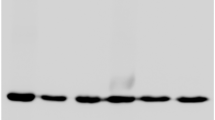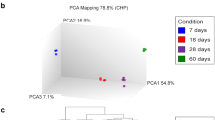Abstract
Expression of a glutamate transporter (EAAC1), a lipocalin (MEP17) and β-galactosidase (β-Gal) in histological sections was used to monitor post-natal development of the murine epididymis. Three epithelia in the adult caput of wild-type mice were distinguished: I, the initial segment; II, the proximal caput; and III, the distal caput. The regions in which epithelia I, II and III were situated were called regions I, II and III, respectively. Regions I, II and III developed from a precursor epithelium present on day 14; from day 16, a presumptive region I epithelium was evident and, by day 21, epithelia characteristic of future regions II and III appeared. The relationship between the c-ros gene and the initial segment was studied by investigating the development of the caput epididymidis in transgenic homozygous c-ros knockout (−/−) mice that lack the initial segment, heterozygous (+/−) males and wild-type males in which the efferent ducts had been ligated prepubertally so that the initial segment failed to develop. In mice with prepubertally ligated efferent ducts, regions II and III developed normally but region I was missing in the adult and expression of c-ros was partially decreased. In (−/−) mice, the precursor epithelium was present, differentiation of epithelium II was delayed until day 32 and epithelium I never developed. Thus, caput region I develops before c-ros expression, high testosterone secretion and differentiation of regions II and III but not if the organ is deprived of the oncogene c-ros or testicular exocrine secretions. The caput of the knockout male lacks solely the initial segment so that the efferent ducts are in continuity with the post-initial segment, proximal caput region. The ligand for c-ros may be present in testicular fluid and both ligand and receptor may be necessary for differentiation of epithelia I and II.





Similar content being viewed by others
References
Abe K, Takano H, Ito T (1982) Response of the epididymal duct in the corpus epididymis to efferent or epididymal duct ligation in the mouse. J Reprod Fertil 64:69–72
Abe K, Takano H, Ito T (1983) Ultrastructure of the mouse epididymal duct with special reference to the regional differences of the principal cells. Arch Histol Japonicum 46:51–68
Abe K, Takano H, Ito T (1984a) Microvasculature of the mouse epididymis, with special reference to fenestrated capillaries localized in the initial segment. Anat Rec 209:209–218
Abe K, Takano H, Ito T (1984b) Interruption of the luminal flow in the epididymal duct of the corpus epididymidis in the mouse, with special reference to differentiation of the epididymal epithelium. Arch Histol Japonicum 47:137–147
Abou-Haila A, Fain-Maurel MA (1984) Regional differences of the proximal part of mouse epididymis: morphological and histochemical characteristics. Anat Rec 209:197–200
Abou-Haila A, Fain-Maurel MA (1985) Postnatal differentiation of the enzymatic activity of the mouse epididymis. Int J Androl 8:441–458
Buckner FS, Wilson AJ, Voorhis WS van (1999) Detection of live Trypanosoma cruzi in tissue of infected mice by using histochemical stain for β-galactosidase. Infect Immun 67:403–409
Cooper TG, Wagenfeld A, Cornwall GA, Hsia N, Chu ST, Orgebin-Crist M-C, Drevet J, Vernet P, Avram C, Nieschlag E, Yeung C-H (2003) Gene and protein expression in the epididymis of infertile c-ros receptor tyrosine kinase-deficient mice. Biol Reprod 69:1750–1762
Fain-Maurel M-A, Abou-Haila A, Dadoune JP (1988) Organization of the internal membrane system in the principal cells of the mouse epididymis after osmium impregnation. Reprod Nutr Dev 28:1237–1250
Fouchecourt S, Lareyre JJ, Chaurand P, DaGue BB, Suzuki K, Ong DE, Olson GE, Matusik RJ, Caprioli RM, Orgebin-Crist MC (2003) Identification, immunolocalization, regulation, and postnatal development of the lipocalin EP17 (epididymal protein of 17 kilodaltons) in the mouse and rat epididymis. Endocrinology 144:887–900
Janca FC, Jost LK, Evenson DP (1986) Mouse testicular and sperm cell development characterized from birth to adulthood by dual parameter flow cytometry. Biol Reprod 34:613–623
Jean-Faucher C, Berger M (1978) Developmental patterns of plasma and testicular testosterone in mice from birth to adulthood. Acta Endocrinol 89:780–788
Kanwar YS, Liu ZZ, Kumar A, Wada J, Carone FA (1995) Cloning of mouse c-ros renal cDNA, its role in development and relationship to extracellular matrix glycoproteins. Kidney Int 48:1646–1659
Keilhack H, Müller M, Böhmer S-A, Frank C, Weidner MK, Birchmeier W, Ligensa T, Berndt A, Kosmehl H, Günther B, Müller T, Birchmeier C, Böhmer FD (2001) Negative regulation of ros receptor tyrosine kinase signaling: an epithelial function of the SH2 domain protein tyrosine phosphatase SHP-1. J Cell Biol 152:325–334
LeBarr DK, Blecher SR (1986) Epididymides of sex-reversed XX mice lack the initial segment. Dev Genet 7:109–116
LeBarr DK, Blecher SR (1987) Decreased arterial vasculature of the epididymal head in XXSxr pseudomale (“sex reversed”) mice. Acta Anat 129:123–126
LeBarr DK, Blecher SR, Moger WH (1986) Androgen levels and androgenization in sex-reversed (XXSxr pseudomale) mouse: absence of initial segment of epididymis is independent of androgens. Arch Androl 17:195–205
LeBarr DK, Blecher SR, Moger WH (1991) Development of the normal XY male and sex-reversed XXSxr pseudomale mouse epididymis. Mol Reprod Dev 28:9–17
Liu ZZ, Wada J, Kumar A, Carone FA, Takahashi M, Kanwar YS (1996) Comparative role of phosphotyrosine kinase domains of c-ros and c-ret protooncogenes in metanephric development with respect to growth factors and matrix morphogens. Dev Biol 178:133–148
Selmanoff MK, Goldman BD, Ginsburg BE (1997) Developmental changes in serum luteinizing hormone, follicle stimulating hormone and androgen levels in males of two inbred mouse strains. Endocrinology 100:122–127
Sipilä P, Cooper TG, Yeung C-H, Mustonen M, Pentinnen J, Drevet J, Huhtaniemi I, Poutanen M (2002) Epididymal dysfunction initiated by the expression of Simian Virus 40 T-antigen leads to angulated flagella and infertility in transgenic mice. Mol Cell Endocrinol 16:2603–2617
Sonnenberg E, Gödecke A, Walter B, Bladt F, Birchmeier C (1991) Transient and locally restricted expression of the ros 1 protooncogene during mouse development. EMBO J 10:3693–3702
Sonnenberg-Riethmacher E, Walter B, Riethmacher D, Gödecke S, Birchmeier C (1996) The c-ros tyrosine kinase receptor controls regionalization and differentiation of epithelial cells in the epididymis. Genes Dev 10:1184–1193
Soranzo L, Dadoune J-P, Fain-Maurel M-A (1982) La segmentation du canal épididymaire chez la souris: étude ultrastructurale. Reprod Nutr Dev 22:999–1012
Takano H (1980) Qualitative and quantitative histology and histogenesis of the mouse epididymis, with special emphasis on the regional difference. Acta Anat Nippon 55:573–587
Takano H, Abe K, Ito T (1981) Effects on the mouse epididymis of juvenile ligation of the ductuli efferentes or proximal epididymal duct: qualitative and quantitative histological studies. Hokkaido Med J 56:133–141
Turner TT, Bomgardner D, Jacobs JP, Nguyen QA (2003) Association of segmentation of the epididymal interstitium with segmented tubule function in rats and mice. Reproduction 125:871–878
Wagenfeld A, Yeung C-H, Lehnert W, Nieschlag E, Cooper TG (2002) Lack of glutamate transporter EAAC1 in the epididymis of infertile c-ros receptor tyrosine-kinase deficient mice. J Androl 23:772–782
Wistuba JSS, Cantauw C, Schonfeldt V von, Nieschlag E, Behr R (2002) Transplantation of wild-type spermatogonia leads to complete spermatogenesis in testes of cyclic 3′,5′-adenosine monophosphate response element modulator-deficient mice. Biol Reprod 67:1052–1057
Yeung CH, Anapolski M, Sipilä P, Wagenfeld A, Poutanen M, Huhtaniemi I, Nieschlag E, Cooper TG (2002) Sperm volume regulation: maturational changes in fertile and infertile transgenic mice and association with kinematics and tail angulation. Biol Reprod 67:269–275
Acknowledgements
This work was funded by the Deutsche Forschungsgemeinschaft (“the male gamete: production, maturation, function”, FOR 197/3-1). We thank Prof. Marie-Claire Orgebin-Crist for the generous gift of anti-MEP17 antiserum and Prof. E. Nieschlag for his continued support.
Author information
Authors and Affiliations
Corresponding author
Additional information
This work was funded by the Deutsche Forschungsgemeinschaft (“the male gamete: production, maturation, function”, FOR 197/3-1)
Rights and permissions
About this article
Cite this article
Avram, C.E., Cooper, T.G. Development of the caput epididymidis studied by expressed proteins (a glutamate transporter, a lipocalin and β-galactosidase) in the c-ros knockout and wild-type mice with prepubertally ligated efferent ducts. Cell Tissue Res 317, 23–34 (2004). https://doi.org/10.1007/s00441-004-0892-8
Received:
Accepted:
Published:
Issue Date:
DOI: https://doi.org/10.1007/s00441-004-0892-8




